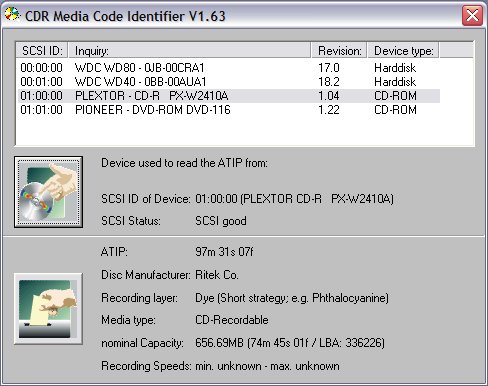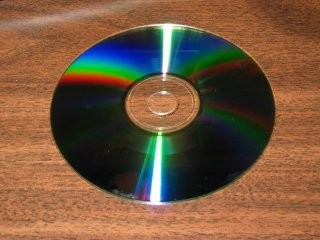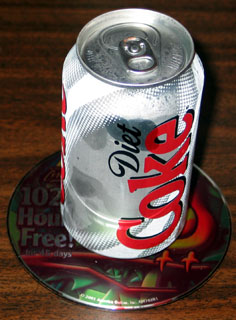
We discussed CD-Recordable longevity a couple of weeks ago on the air during one of our "missing guest" induced time fillers. I mentioned that CD-Rs may last anywhere from 5 or 10 years up to 100 years. I also mentioned that nobody knew for sure how long CD-Rs may last. Those statements were based on extensive research of the conventional wisdom that I had done a couple of years ago when our company was planning to release a catalog produced in house and distributed on CD-R.
But I digress. As soon as I finished my sentence, our own Severian (thank you!) sent Jack and I a link to this article at CD Freaks, a well-known enthusiast site. The article references a Dutch magazine, PC-Active. The story was also picked up in The Register this week. Here it is in its original Dutch: PC-Active CD-R's binnen twee jaar onleesbaar. Basically, they say that they tested 30 brands of CD-Rs and that in 20 months a number of them were completely or partially unreadable. If this is a widespread happening, this is a matter of concern to all who use CD-R to archive data, music, video and photos.
This article sent Jack and I on a journey to discover the truth. So far, I have been unable to find much to support the article. I did find a similar result of a distinctly different phenomenon, the CD eating fungus, but the fungus apparently requires a tropical environment to live and the fungus ate CDs, not CD-Rs. That doesn't mean the PC-Active article is wrong. It just means I just can't find other evidence of this kind of CD-R failure happening elsewhere.
I'm also concerned because as best I can tell (I don't read Dutch, but I did run the article though translating software to try to double-check) PC-Active gives few details as to how the tests were conducted, who conducted the tests, or even which brands of CD-Rs were tested. This lack of detail (unless I missed them in the translation) is troubling. If this is just a summary of a longer article with more details that appears in the print version of the magazine, I apologize in advance -- at this point, I just don't know and I have very little from PC-Active to go on.
Here are the results of several searches of Google Groups. I my hypothesis is that Usenet would be screaming over this if a large number of CD-Rs were turning up unreadable after a year or two.
These are just a few searches that I did -- you are welcome to create your own. Also, you may want to re-sort the results by date to see the most recent posts. I didn't see anything I considered significant about CD-R longevity, but I may have missed something. Please search and read for yourself. (Remember if you are reading this significantly after I wrote it, those searches will be more current -- something may have turned up at a later date).
Next on my search for the truth, I turned to the venerable CD-Recordable FAQ. The FAQ has a whole section about CD-R longevity including links to other sources. A site that addresses CD-R quality that is referenced in the CD-R FAQ is Media Sciences; Computer Media Quality. So at this point the best information I can find on the subject doesn't lend much support to my drawing broader conclusions about CD-R longevity from the PC-Active article.
Of course, my search for anecdotal evidence one way or the other doesn't even approach a scientific study. Until we have a controlled study and some reproducible results, my own experience with CD-R reliability is probably as good an indicator as for me of their viability as a storage medium as anything else. However, because many of us like to wear "a belt and suspenders" I store any truly irreplaceable data on at least 2 different kinds of media stored in 2 different places. I always have done that and I probably always will.
My conclusion to date is that one data point in a computer magazine does not a panic make; but for critical data, it is better to be safe and have back-ups of your back-ups on several different media.
Not all CD-Rs are created equal, but how do you tell them apart? The answer is: with great difficulty.
Here's the CD-R. It is branded Maxell, but who really made it? Does
anybody know? (FYI this is an archived licensed copy of NAV downloaded from
Symantec last week).

The ATIP as read by CD-R
Media Code Identifier. According to the CD-R
FAQ the only reliable information to be gleaned from reading the ATIP is the
disk length. We can tell that Ritek made the master and that the master was made
to be used with Phthalocyanine. By the way this Maxell CD-R would not be
considered by serious CD-R users to have the finest pedigree even though Phthalocyanine
is considered to be a good dye. Some manufacturers produce better quality CD-Rs
and some lower quality even if they use the same basic materials. Name
brand is no guarantee either, since the CD-Rs for one brand may be made by one or
more manufacturers.

Here's the bottom of the same CD-R. Its difficult to capture the color in
a photo due to the reflective layer,
but it sure could be Phthalocyanine. To my eyes the color is really a very
light aqua-metallic gold.
For those who are interested, here is an article about various CD-R dyes and who uses which ones. They also list some brands which generally are made by the better and worse manufacturers. Price is often an indicator, but not always. You can pay a lot for poor quality or you can pay little for great quality CD-Rs. For the average consumer it can be difficult to tell which is which from the outer packaging.
 With improved CD-Writers and technologies like
Burn-Proof (tm) it is getting
more and more difficult to ruin CD-Rs, but with a little effort it can still be
done. Or you can simply collect a few AOL CDs -- the traditional CD you
love to trash. Whatever the source, here the some links to number of
fun and even profitable projects that you can make from your discarded CDs.
With improved CD-Writers and technologies like
Burn-Proof (tm) it is getting
more and more difficult to ruin CD-Rs, but with a little effort it can still be
done. Or you can simply collect a few AOL CDs -- the traditional CD you
love to trash. Whatever the source, here the some links to number of
fun and even profitable projects that you can make from your discarded CDs.
For fun ideas or even ready made items for sale, see the following Web pages:
And of course you an always send the AOL CDs to this guy --
Gail
© 2003 Gail Allinson
© 2002 - 2004 by On Computers and the Videotex Services Coalition.![]()